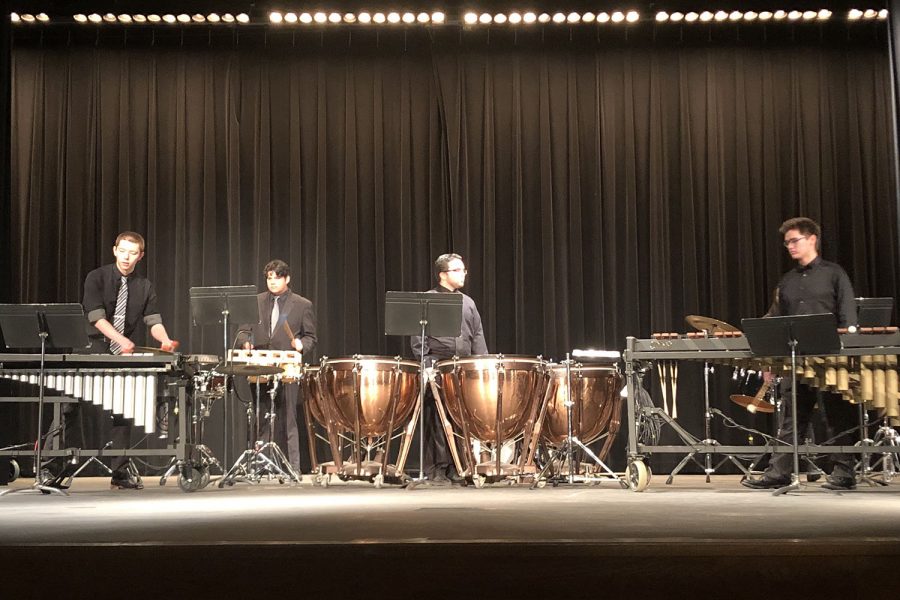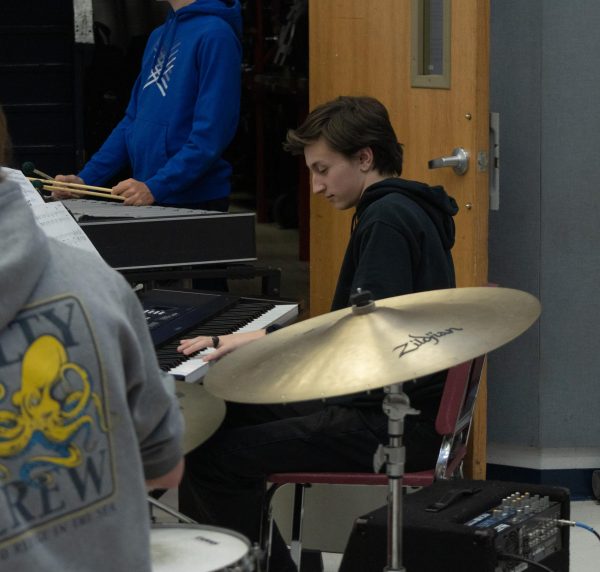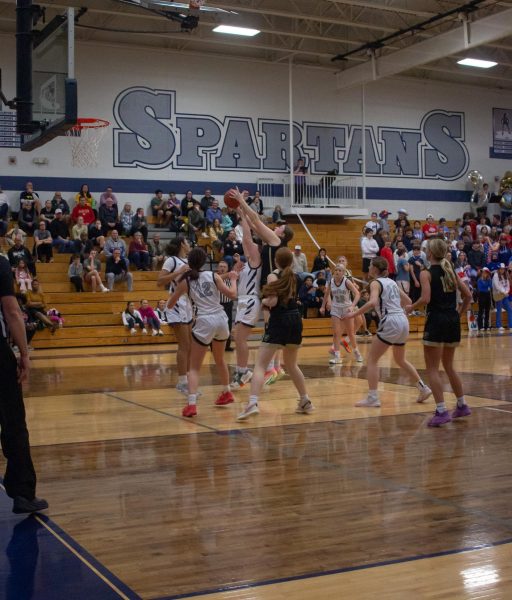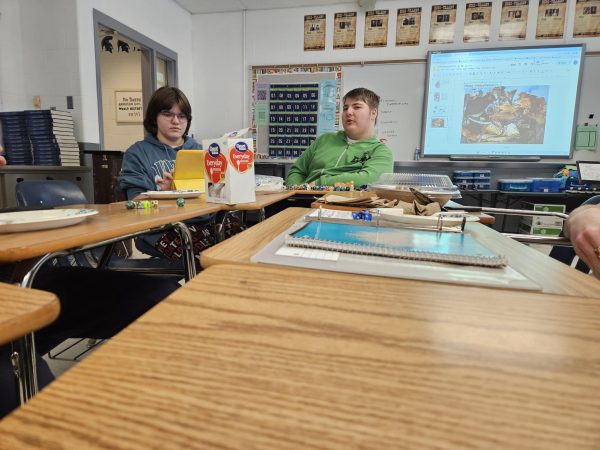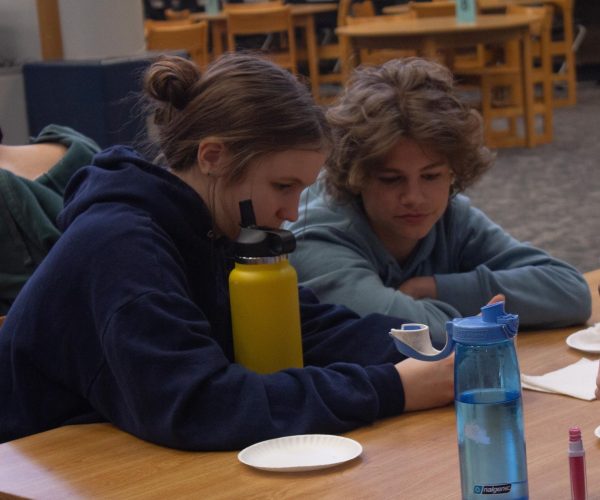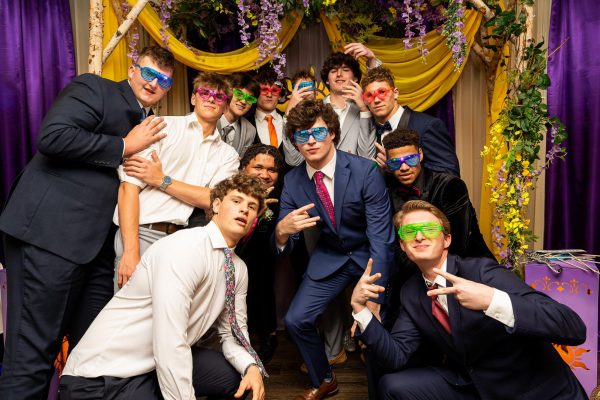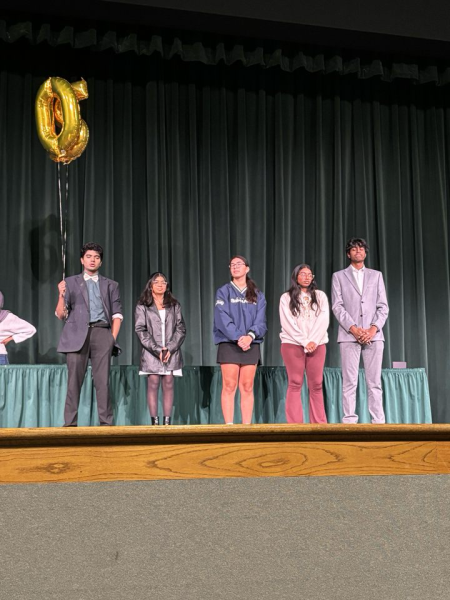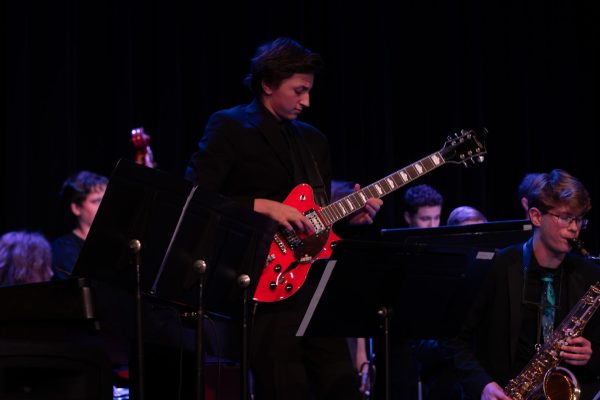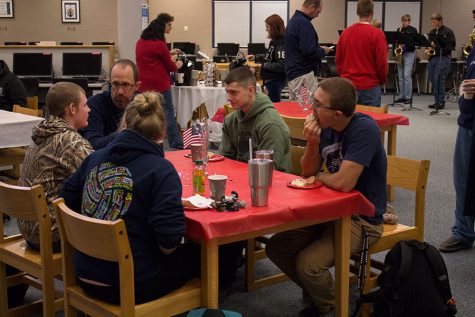Taking The Lead
Musicians from the Wind Ensemble and Jazz Ensemble hosted a student-led concert
PERCUSSION: The last wind ensemble group to perform was a percussion feature. The members of this group are Chris Bissett, Sam Bippen, Connor Banden, Alex LaBanca, and Emma Smallen.
It was getting dark outside as the band room bustled with performers practicing or talking to their friends to alleviate the tension from the first ensemble performance of the year. Meanwhile, relatives and peers lined up in the auditorium atrium waiting to get seated.
On Thursday, November 14, the Wind Ensemble and Jazz Ensemble students performed their small groups in the Francis Howell Central auditorium at 7 PM. Their small groups, chosen music and concert were all ran by the students themselves. Sophomore Allison Hoefle performed on her bass clarinet. Hoefle and her group, as well as the other small ensembles, made all of their musical decisions themselves with only a bit of feedback from the band directors.
“[The Directors] didn’t really give us any guidance, it was like [a] free for all. We got to make the musical decisions and then they just gave us feedback. Like, ‘you can maybe try this, but it’s ultimately your choice,’” Hoefle said. “We worked during class, we did a lot of tuning in the chords and trying to find what sounds the best.”
Mr. Nathan Griffin and Mr. Andrew Messerli put together this project to give students a chance to become better musicians through letting them make their own musical decisions. They assigned it in mid September to early October, depending on the class. Despite the amount of time they had to prepare for this performance, senior Sam Bippen recalled some class periods were dedicated to other projects, such as the winter concerts.
“We would have a day each week to work on it, and then the last week [before the concert] we cranked it full gear, and we had every day to prepare it,” Bippen said.
To start the project, the students picked their groups based on their instruments. Hoefle, for example, was in a group with four clarinets. The next step was to pick the music they play. Some groups, such as Hoefle’s, looked through the music archives to find songs that would catch their interest, then would look them up online to decide. Other groups, such as Bippen’s, had already bought music before the project. However, senior PJ Sheehan and his group for wind ensemble had a lot of trouble trying to find the right piece, due to their unique instrumentation, until they found it at a local music store.
“For the jazz piece, we just kind of flipped through a book that they had of different parts, and we found Bluebird and we were like ‘okay great.’ Then we printed it off and went to go practice it,” Sheehan said. “The small ensemble one took a little bit more time because we had kind of a weird group, so we had to work around our instrumentation, and we were able to find a piece at a local music shop.”
Once the groups found the music they wanted to play, they had to practice staying in time with one another, as no one would be standing in front of them to conduct. Just like the approach to the actual music, different groups had different ways of staying in time. For most of the Wind Ensemble groups, such as Hoefle’s, they stayed in time by using eye contact along with movements such as foot tapping, swaying, and moving instruments.
“We made a lot of eye contact and Brent moved his instrument a bit whenever we did our tempo changes,” Hoefle said.
The two percussion groups from Wind Ensemble, as well as the Rhythm Section from Jazz Ensemble, focused less on watching one another in favor of listening to each other’s parts. The two percussion groups from Wind Ensemble especially had to listen to each other because certain parts did not play the whole time and also required an instrument switch. The Rhythm Section on the other hand, also accompanied the small jazz groups on top of playing their own featured piece, making the group closer together and helping them get used to each other’s sense of time.
“It’s a lot of listening to one another because, at least in wind ensemble, you’re not playing the whole time. There are sections where you’re featured and then sections where vibes are featured or something,” Bippen said. “So you have to really listen and be able to adapt to whatever goes on with the other people. In jazz, we just work together because you basically are playing the whole time for that one.”
After performing with the small jazz groups, it was time for the Rhythm Section’s featured piece, Take Five. The highlights of the song was each instument getting a chance to shine with their own solo. However, Bippen and fellow percussionist Emma Smallen had to find a way to play their respective drum solos on one drum set. After a lot of deliberation, Smallen had the idea on how to switch in a dream. After describing it to Bippen, the pair began practicing it during their rehearsals.
Once the time came for their final song, Smallen started on the drums. The solos passed around the section, until it was Smallen’s turn. Towards the end of her solo, a single hand holding a drumstick pushed through the curtain and began hitting the snare drum. A few seconds later, the curtains parted to reveal Bippen, who then quickly swapped places with Smallen. As they completed the switch, the crowd erupted in applause and Bippen completed the song with his own solo.
“Mr. Griffin had said we had to incorporate everyone into Take Five so I was just gonna sit off and not play at all, but then [Griffin] said that everyone has to play in it so we had to find an opportunity to switch,” Bippen said. “Emma, actually had that idea in a dream and came to me one day and she was like, ‘I had the craziest dream with an idea of how we will switch and it just might work,’ and it did work and it was cool.”
Along with the big switch between Bippen and Smallen at the end, the entire rhythm section did their own solo, including guitarist Sam Hillig. Since improvising is a big part of jazz, many of the students in Jazz Ensemble improvised a small portion of their performance, weither by deciding what it would be beforehand or improvising during the show, as Hillig did.
“I mean, a lot of people did do preemptive solos, they worked on stuff but I tried to improvise most of the time. Mine was improvised [but] I’m not sure about everyone else’s,” Hillig said. “[to prepare] I listen to a lot of different artists and things like that so I have an idea of what I want to play beforehand and then I just kind of go with it when I started so that’s basically just what I do.”
Your donation will support the student journalists of Francis Howell Central High School. Your contribution will allow us to purchase equipment and cover our annual website hosting costs. FHCToday.com and our subsequent publications are dedicated to the students by the students. We hope you consider donating to allow us to continue our mission of a connected and well-informed student body.



